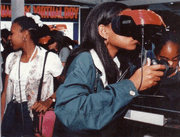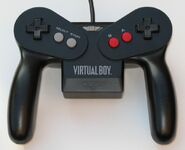|
The Virtual Boy is a failed portable video game console released in 1995 by Nintendo. The system used a monochromatic (red and black) visor that simulated a 3D view on its games. It is noteworthy for being one of the few failed products of Nintendo. It was the last product former veteran Nintendo-designer Gunpei Yokoi had developed.
The Virtual Boy had several flaws that led to its discontinuation after just one year. One of the reasons it failed is because it was slightly rushed to get the people on the team to work on the Nintendo 64 (then dubbed the "Ultra 64") and development was expensive. For some people it also caused eye strain after playing it for a while. The console also had an EXT. port, presumably for multiplayer features. If this was the case, the Virtual Boy never got around to releasing a multiplayer cable, possibly due to the console's low ratings and discontinuation.
Information
The 3D images produced are only hues of red and black instead of full color graphics. An AC adapter was manufactured for the system that could be purchased separately to charge the Virtual Boy rather than inserting six AA batteries in the controller that quickly dries out in approximately four hours. Only about twenty video games were released for the Virtual Boy as it discontinued very quickly in early 1996.
The 3D effects are a result of two 1x224 linear arrays, each one directed to an eye that are presented to the player through oscillating mirrors that cause the Virtual Boy to emit a murmur. The 3D effect can cause trauma in the ocular area (in fact, Nintendo urged parents not to let children under the age of seven to play the system since it had the potential to damage their eyes). Knowing this, Nintendo inserted an option within each Virtual Boy game released that pauses the game every fifteen or thirty minutes.
Some critics questioned Nintendo's use of only red and black for the Virtual Boy. This choice was both monetary and functional, though at the same time was not entirely appealing to the consumer. Nintendo claimed that colors other than red were more expensive and drained the battery more quickly than four hours approximate.
Controller
The Virtual Boy's controller features two D-pads on opposite ends implemented for the player to play along a Z axis. This is the only Nintendo controller that features two D-pads. Aside the D-pads, there are four buttons, a gray START button and SELECT button, and an A button and B button, both red. There is also a portion of the controller that is in the battery compartment in the middle. This gives the controller the shape of an "M".
Specifications
| Processor | NEC V810 32-Bit RISC Processor at 20 MHz clock speed 1MB of DRAM, 512 of KB P-Sram 1 KB Cache |
| Display | Reflection Technology Inc SLA dual mirror-scan, high resolution LED displays Resolution: 384 x 224 pixels 50.2 Hz Horizontal Scan Rate 4 colors with 32 levels of intensity |
| Power Supply | Six AA batteries (lasts for approximately four hours) or an AC adapter |
| Sound | 16-Bit Stereo Built-in Stereo Speaker |
| Serial Port | 8 Pin Cable Bandwidth 50-100 KBit/second |
| Weight | 760 g |
| Dimensions | 8.5"H x 10"W x 4.3"D |
| • 128 MBit addressable ROM space
| |
Development

A woman playing the Virtual Boy at E3 1995.
The Virtual Boy is best known one of Nintendo's worst failures and Gunpei Yokoi's last product during his working efforts at Nintendo. Yokoi had been with Nintendo for years, developing toys for them long before they ever planned on entering the video game industry. Nintendo's long-term success can even be attributed to the developer, who went on to develop the Game & Watch, the Game Boy, and several classic Nintendo franchises. Gunpei Yokoi long intended the Virtual Boy to be his last project at the company. Some fans have speculated that Yokoi left because of the failure of the Virtual Boy or that he was fired. In reality he had planned to retire long before his departure (he actually had stayed four years longer than planned).
Nintendo R&D1, the team Yokoi ran, contained around sixty people that all worked tirelessly on the Virtual Boy. The deal to work with Reflection Technologies Inc, a United States based company, was finalized around 1991 or 1992, though at the time neither company had a clear vision of what they wanted to do just yet.
Gunpei Yokoi admitted in 1994 that very few publishers outside of Nintendo were given development kits to create games for the system. When pressed to explain why this was the case, he stated that Hiroshi Yamauchi, the then president of Nintendo, had made this decision in order to control the quality that would be released for the Virtual Boy. In Gunpei's words, "we want to limit that danger and maintain as much control as possible." Nintendo of America in Redmond, Washington viewed the situation in a different way. Knowing that the Virtual Boy wasn't a success in Japan, Nintendo of America tried to enlist as much help as possible to launch the system in the states and Canada. Prior to the launch, they held a developer's conference in the Seattle area that lasted for two days.
David Sheff, the author of the popular video game history book Game Over, has stated that Gunpei was unsatisfied with the end product. Wanting to work on it further, Nintendo thought it was good enough and pushed the title out to retailers so that they could work almost exclusively on their Nintendo 64 console.
Sales and reception
The end product was less than satisfactory to critics and consumers alike. Nintendo was also extremely disappointed with the sales of the system. Before being discontinued by Nintendo, the Virtual Boy had sold only 770,000 units worldwide (Japan and North America). Prior to the release of the system, Gunpei Yokoi had stated that he and Nintendo had expected to sell in excess of three million copies in its first year in Japan alone.
Nintendo of America, perhaps even more than their Japanese parent, tried very hard to sell as many units as possible. They even went as far as to spend twenty five million dollars on marketing. Ultimately, this was a waste as nothing came of it. In fact, of the 770,000 units sold, only 140,000 were bought by Americans in the United States and Canada. In Japan, the disaster was less profound, with Nintendo pushing a still very small 630,000 units. The Virtual Boy was never released in Europe or Australia possibly because it was unsuccessful in Japan and North America.
Interestingly, Nintendo of America claimed to have sold every Virtual Boy they shipped out at launch. However, this was primarily because most stores had only purchased a couple units from the company. After the second shipment Nintendo probably realized that the Virtual Boy would not be the success they wanted, responding to the consumer's reactions by cutting the price from one hundred seventy-nine to one hundred fifty-nine dollars and later to ninety-nine dollars.
Nintendo and third parties developed advertising campaigns for the Virtual Boy and the games that were released for it. The ad campaigns each had relevant titles such as "A 3D game for a 3D world", "Turn it on Virtual Boy", and when the Virtual Boy's price was reduced to ninety-nine dollars, "New Low Fare to the Third Dimension".
Legacy
As a tribute to Nintendo's history the Virtual Boy has had small references in games like Super Smash Bros. Melee and Warioware Inc. There also appeared one in Super Paper Mario, as a part of Francis's collection of video games.
There is also an incredibly strong homebrewing community at Planet Virtual Boy.In fact, they have made homemade link cables and programmed for it.
The Virtual Boy was not Nintendo's first excursion into the 3D industry and was not their last. Nintendo had experimented with 3D all the way back to the Famicom with the Famicom 3D System. While not released internationally, games with 3D functionality could be properly viewed with 3D glasses. Very few games were released on the 3D system, with the most noteworthy titles being Famicom Grand Prix II: 3D Hot Rally and Highway Star (Rad Racer outside of Japan).
Following the release of the Virtual Boy, Nintendo experimented with 3D for the Nintendo GameCube, with longtime Nintendo employee Hideki Konno saying that Luigi's Mansion in particular looked excellent. This idea was scrapped as the add-on would have been more expensive than the console itself. In June 2010, Nintendo revealed the Nintendo 3DS, a system that supported 3D graphics without the need for glasses. This console was released on March 27, 2011 in North America.
In August 1995, the Virtual Boy was featured on the cover of Nintendo Power V75.

